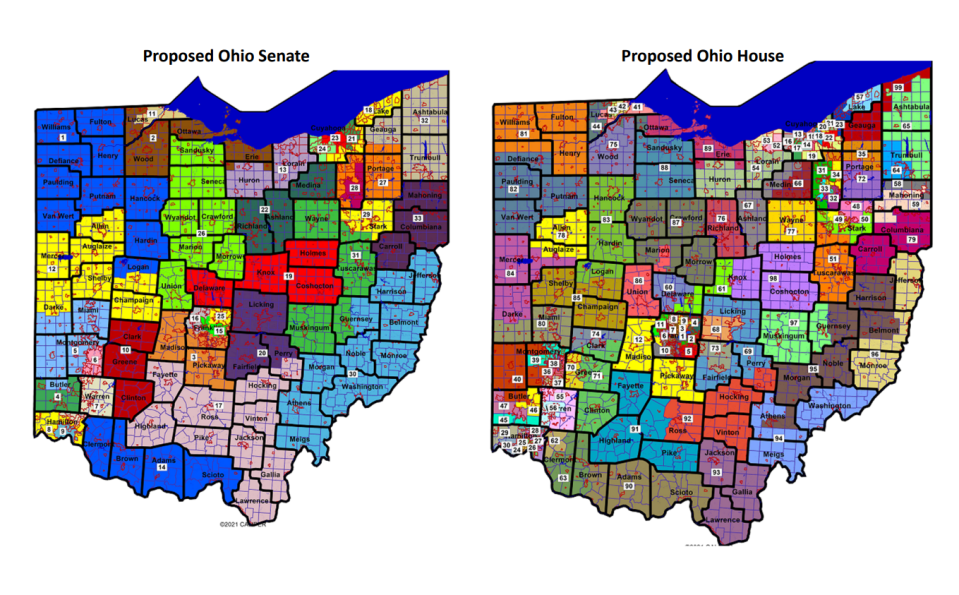Ohio redistricting: Republicans unveil proposed House, Senate maps ahead of hearings

- Oops!Something went wrong.Please try again later.
- Oops!Something went wrong.Please try again later.
Republicans unveiled new state House and Senate maps Wednesday that they swiftly adopted as the full commission's working document − over Democrats' objections.
Sen. Rob McColley, R-Napoleon, said the maps he introduced Wednesday would give Republicans a 23-10 advantage in the Senate and a 62-37 advantage in the House. Across the entire plan, six Republican districts and 10 Democratic districts would be tossups, he said.
Those numbers wouldn't match the statewide voting preferences of Ohioans as required by voter-approved changes to curb partisan gerrymandering, said House Minority Leader Allison Russo, D-Upper Arlington. “Let’s be clear, this does not by any stretch of the imagination meet the proportionality requirement."
But there's a dispute already brewing about what that requirement is, and how hard mapmakers need to try to hit it. That fight could include whether to swap out 2012 data, from when then-President Barack Obama and Sen. Sherrod Brown won handily, for the 2022 election results where Gov. Mike DeWine easily defeated Democratic opponent Nan Whaley to win re-election.
That change could shift the statewide voting preferences from 54% Republican and 46% Democratic, the ratio courts used to analyze plans in 2022, to closer to 57% Republican and 43% Democratic.

In the current Ohio Legislature, Republicans hold nearly 79% of Senate seats and almost 68% of House seats. In several instances, GOP candidates won districts that favored Democrats.
But Ohio Auditor Keith Faber, a Republican, said the math could be moot. "There's also an argument that you don't get to the magical, mystery ratio depending on how you draw the rest of the maps," he said.
The Ohio Supreme Court, which would review any final map, is also under new leadership. New Chief Justice Sharon Kennedy would have approved past maps as legal and the swing vote on past rulings, former Chief Justice Maureen O'Connor, was required to retire because of age limits on judges.
The proposed GOP plan would also keep Cincinnati, Akron and Toledo in their own state Senate districts. McColley said the goal was to keep communities together; Democrats questioned whether that amounted to packing Democratic voters.
Russo criticized Republicans for providing only printouts of the proposed maps during Wednesday's hearing − without details that would allow them to easily analyze them. She questioned whether two Democratic representatives in Franklin County would be pitted against one another in the same district; McColley said they were not.
Commission faces tight deadline as 2024 election looms
The seven-member Ohio Redistricting Commission is tasked with drawing districts for 99 House and 33 Senate seats. The process of drawing those lines, called redistricting, is typically done every decade to adjust for people moving to different parts of the state.
Ohio voters overwhelmingly approved changes in 2015 to curb gerrymandering, which occurs when mapmakers manipulate district boundaries to guarantee a particular result. A divided Ohio Supreme Court repeatedly ruled that districts the commission approved in 2021 and 2022 violated those anti-gerrymandering rules.
Now, the commission must draw maps for the 2024 elections. They are under a tight timeline because legislative candidates must officially declare they are running in December.
DeWine tested positive for COVID-19 Tuesday, preventing him from attending in-person meetings for several days. That could complicate holding a vote on the maps, but Senate President Matt Huffman, R-Lima, said any vote is unlikely to happen before the end of next week.
Any final plan would need at least four votes to take effect for the 2024 elections. For the maps to last through the 2030 elections, both Democrats would need to vote for them.
The commission set three hearings for the public to weigh in on maps as required by the Ohio Constitution. Democrats criticized the short timeline and lack of meetings in Cincinnati, Cleveland or other large cities.
10 a.m. Friday at Deer Creek State Park.
10 a.m. Monday at Punderson Manor Lodge & Conference Center.
10 a.m. Tuesday at the Ohio Statehouse.
Wednesday's meeting came after a week of delay over who should lead the commission. Top Republican lawmakers were tasked with picking a co-chair for the GOP but couldn't agree on a final choice last week. Ultimately, they chose Faber to represent Republicans. Senate Minority Leader Nickie Antonio, D-Lakewood, will serve as the other co-chair.
“We are looking forward to a fair and balanced process. We are very hopeful about that," Antonio said.
On Tuesday, Antonio and Russo released legislative maps they say would give Republicans a 19-14 advantage in the Senate and a 56-43 advantage in the House. They argued that Republicans must relinquish some safe seats to pass maps that pass constitutional muster.
Republicans on the commission did not adopt these maps as their working version. Huffman said earlier in the day: "I did think it was ironic that they said we shouldn't have a map drawn by one party and then they presented a map drawn by only one party."
Jessie Balmert is a reporter for the USA TODAY Network Ohio Bureau, which serves the Columbus Dispatch, Cincinnati Enquirer, Akron Beacon Journal and 18 other affiliated news organizations across Ohio.
This article originally appeared on Cincinnati Enquirer: Ohio redistricting: Republicans release working maps ahead of hearings

